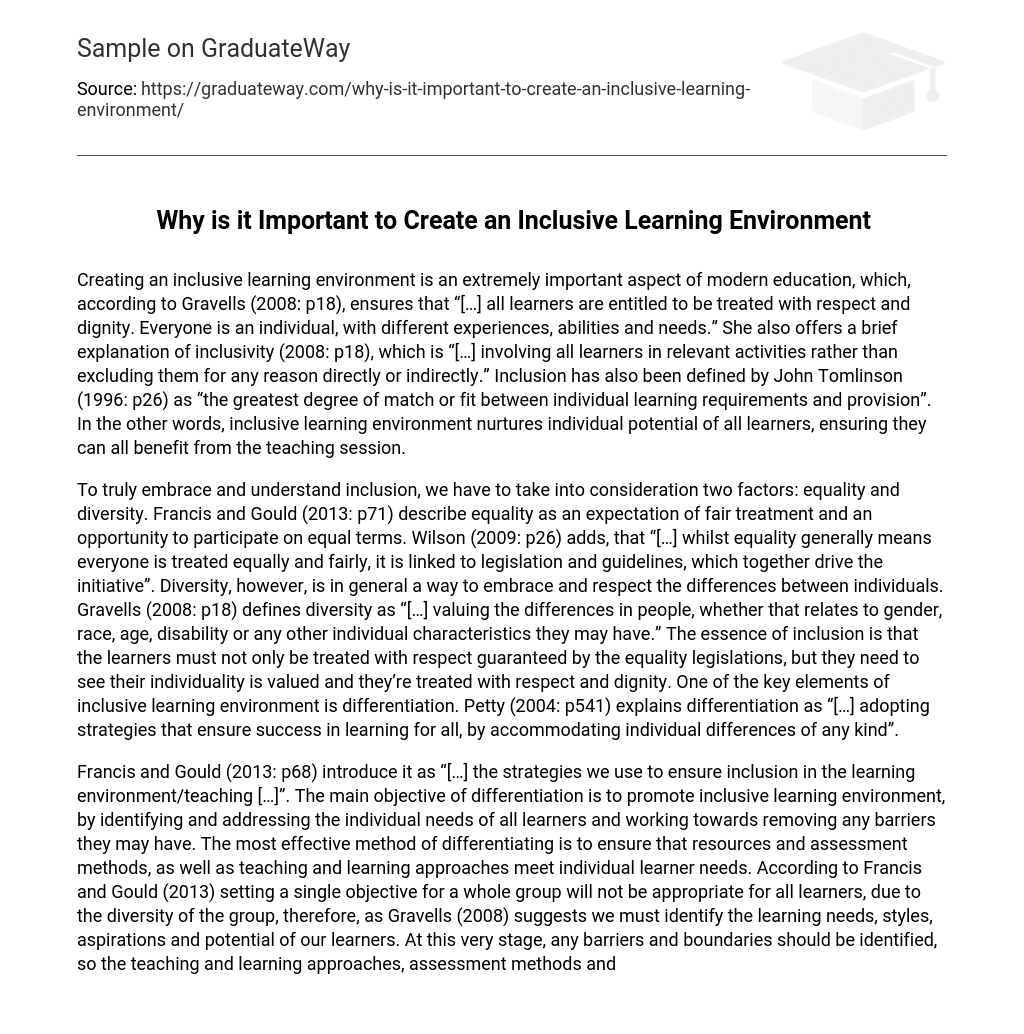Creating an inclusive learning environment is an extremely important aspect of modern education, which, according to Gravells (2008: p18), ensures that “[…] all learners are entitled to be treated with respect and dignity. Everyone is an individual, with different experiences, abilities and needs.” She also offers a brief explanation of inclusivity (2008: p18), which is “[…] involving all learners in relevant activities rather than excluding them for any reason directly or indirectly.” Inclusion has also been defined by John Tomlinson (1996: p26) as “the greatest degree of match or fit between individual learning requirements and provision”. In the other words, inclusive learning environment nurtures individual potential of all learners, ensuring they can all benefit from the teaching session.
To truly embrace and understand inclusion, we have to take into consideration two factors: equality and diversity. Francis and Gould (2013: p71) describe equality as an expectation of fair treatment and an opportunity to participate on equal terms. Wilson (2009: p26) adds, that “[…] whilst equality generally means everyone is treated equally and fairly, it is linked to legislation and guidelines, which together drive the initiative”. Diversity, however, is in general a way to embrace and respect the differences between individuals. Gravells (2008: p18) defines diversity as “[…] valuing the differences in people, whether that relates to gender, race, age, disability or any other individual characteristics they may have.” The essence of inclusion is that the learners must not only be treated with respect guaranteed by the equality legislations, but they need to see their individuality is valued and they’re treated with respect and dignity. One of the key elements of inclusive learning environment is differentiation. Petty (2004: p541) explains differentiation as “[…] adopting strategies that ensure success in learning for all, by accommodating individual differences of any kind”.
Francis and Gould (2013: p68) introduce it as “[…] the strategies we use to ensure inclusion in the learning environment/teaching […]”. The main objective of differentiation is to promote inclusive learning environment, by identifying and addressing the individual needs of all learners and working towards removing any barriers they may have. The most effective method of differentiating is to ensure that resources and assessment methods, as well as teaching and learning approaches meet individual learner needs. According to Francis and Gould (2013) setting a single objective for a whole group will not be appropriate for all learners, due to the diversity of the group, therefore, as Gravells (2008) suggests we must identify the learning needs, styles, aspirations and potential of our learners. At this very stage, any barriers and boundaries should be identified, so the teaching and learning approaches, assessment methods and resources can be planned accordingly.
When setting up an inclusive learning environment we need to focus on individual differences. Francis and Gould (2013: p65) explain, that “it is important to recognise the differences in the learners we teach, as these influence how we interact with them.” Francis and Gould (2013) list few typical differences, like age, physical disability, mental health issues, ethnicity, etc. Our first step to identify the individual learning style of the learners’ (ergo to identify their needs), is performing ‘VAK’ (visual, aural, kinaesthetic) assessment. Francis and Gould (2013) describe it as a model of categorising individual learning preferences.
To achieve the best possible result when creating an inclusive learning environment, we have to always think about resources we’re going to use during the session. Wilson (2009) lists few examples of resources which can help learners to overcome their barriers. These can be enlarged handouts, altered font types and size, assistive technology, i.e. keyboards or mouse alternatives, visual images and modern technology, like Virtual Learning Environment or the Internet. Other resources – as Francis and Gould (2013) suggest – can include use of coloured paper, clear enunciation, hearing loops or adaptive software for visually impaired.
Assessment methods are also an extremely important part of creating an inclusive learning environment, because, according to Gravells (2008: p79) “[…] methods of assessment […] should all be adapted to suit individual needs”. Francis and Gould (2013: p129) define assessment as “[…] all those activities and process involved in judging performance or measuring learner achievement”. The assessments can also be adapted to the individual learners’ needs, as according to Wilson (2009) we can alter the questioning techniques or amend complexity of written questions.





